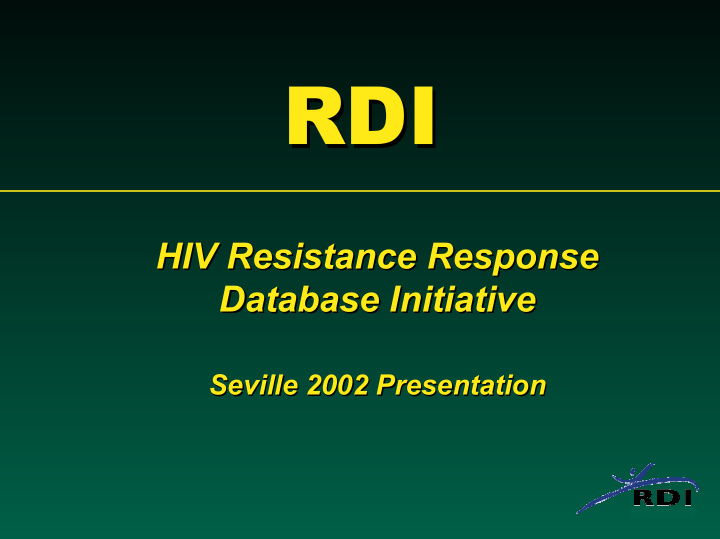



RDI RDI RDI RDI HIV Resistance Response HIV Resistance Response Database Initiative Database Initiative Seville 2002 Presentation Seville 2002 Presentation
Goal Goal • To develop a relational database to To develop a relational database to • correlate HIV drug resistance- - correlate HIV drug resistance associated genotype data with associated genotype data with response to antiretroviral agents response to antiretroviral agents
Aim Aim • Initial aim is to collect genotype, treatment Initial aim is to collect genotype, treatment • & clinical outcome information (VL &CD4) & clinical outcome information (VL &CD4) from substantial numbers of patients from substantial numbers of patients • To To organise organise data in an oracle data in an oracle- -based based • relational database relational database • To To analyse analyse data using a number of data using a number of • approaches to relate resistance mutation approaches to relate resistance mutation patterns with clinical response patterns with clinical response • Provide wide access to interrogation of Provide wide access to interrogation of • data via the internet data via the internet
Core Team Core Team • Mission of the Core Team: Mission of the Core Team: • • Contribute data & Develop database Contribute data & Develop database • • Ensure data meets appropriate QA Ensure data meets appropriate QA • standards standards • Develop initial data analysis plan Develop initial data analysis plan • • Review requests to Review requests to analyse analyse data from data from • the database the database
Data Input Data Input Sequence Sequence DATABASE VL & CD4 VL & CD4 DATABASE (bl ( bl & follow & follow- -up) up) Therapies Therapies
Data QA Data QA • Specific QA standards applied to Specific QA standards applied to • data submitted to the database data submitted to the database • Developed for : Developed for : • • Clinical Data (Cohort, Clinical Trial) Clinical Data (Cohort, Clinical Trial) • • Sequencing Data (RT, Protease regions) Sequencing Data (RT, Protease regions) •
Data Analysis Data Analysis • Data identified from about 3500 patients Data identified from about 3500 patients • – More when additional genotyping performed More when additional genotyping performed – • Oracle database hardware & software in Oracle database hardware & software in • place (with dedicated support) place (with dedicated support) – DB architecture constructed DB architecture constructed – • Power calculations have been performed Power calculations have been performed • to estimate approx. number of required to estimate approx. number of required data points (see data points (see DiRienzo DiRienzo & & DeGruttola DeGruttola) ) • Initial NN models constructed Initial NN models constructed (see Wang et al) • (see Wang et al)
Neural Network Model Neural Network Model (Dechao Dechao Wang et al) Wang et al) ( Mutations Mutations predicted predicted Neural Neural VL VL ∆ VL ∆ VL Network Network (bl ( bl & follow & follow- -up) up) Therapies Therapies
62- -Parameter Neural Network model Parameter Neural Network model 62 (Dechao Dechao Wang et al) Wang et al) ( • Input variables Input variables • - 20 PI 20 PI codon codon positions positions - - 29 RT 29 RT codon codon positions positions - - 12 drugs (5 PIs, 5 12 drugs (5 PIs, 5 NRTIs NRTIs, 2 , 2 NNRTIs NNRTIs) ) - - Duration of therapy (weeks) Duration of therapy (weeks) - • Output variable Output variable • - Viral load change at on Viral load change at on- -therapy time therapy time - points points
VGI Vigilance II Database VGI Vigilance II Database Viral load Viral load ( 598 ) ( 598 ) Genotype Genotype (781 ) (781 ) Regimen Regimen (715 ) (715 ) 442 samples 442 samples
Linear Regression Analysis: Linear Regression Analysis: Training Set Training Set Training set (n=639) R 2 = 0.85 4 Predicted viral load 2 change 0 -4 -3 -2 -1 0 1 2 3 -2 -4 Actual viral load change
Linear Regression Analysis: Linear Regression Analysis: Independent Set Independent Set Validation set (n=63) 3 R 2 = 0.55 2 Predicted viral load 1 change 0 -4 -3 -2 -1 -1 0 1 2 3 -2 -3 -4 Actual viral load change
Predicting VL Trajectory: Predicting VL Trajectory: Test Data Set Test Data Set NN Prediction: 75%±1.8% Viral Load correct (~86/115) Time
“In silico silico” Response Prediction ” Response Prediction “In • Baseline genotype for a virtual patient Baseline genotype for a virtual patient • - RT: 41, 67, 118, 210, 215 RT: 41, 67, 118, 210, 215 - - PI: 10, 46, 82, 90 PI: 10, 46, 82, 90 - • Alternative therapy regimens Alternative therapy regimens • a. D4T, ddI ddI, , Kaletra Kaletra a. D4T, b. D4T, ddI ddI, , indinavir indinavir b. D4T, c. AZT, 3TC, Kaletra Kaletra c. AZT, 3TC, d. AZT, 3TC, indinavir indinavir d. AZT, 3TC,
“In silico silico” Response Prediction ” Response Prediction “In 3 2 Viral Load (log 10 ) D4T/ddI/IDV 1 0 AZT/3TC/IDV D4T/ddI/Kal -1 AZT/3TC/Kal -2 Baseline week 8 week 16
Summary Summary • The RDI is focused on establishing relationships • The RDI is focused on establishing relationships between baseline genotype & virological between baseline genotype & virological response via analysis of a large clinical dataset response via analysis of a large clinical dataset • Significant progress has been made: • Significant progress has been made: – Sources of data identified – Sources of data identified – Database architecture constructed – Database architecture constructed – Modeling work has begun – Modeling work has begun • This initiative is open for groups to join & aims to • This initiative is open for groups to join & aims to provide open access to query the database provide open access to query the database • Utilization of large databases is likely to improve • Utilization of large databases is likely to improve the accuracy of genotypic interpretation the accuracy of genotypic interpretation
Recommend
More recommend